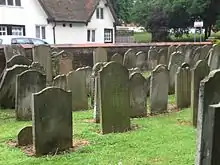George Edward Doney
George Edward Doney (~1758 - 1809) is believed to have been born in Gambia around 1758. He was transported to Virginia as a young boy and sold into slavery. He came to Watford, Hertfordshire in around 1765, as a servant for the Earl of Essex at Cassiobury House, continuing to serve the family for 44 years.[1]


He achieved respect and status at Cassiobury House and was baptised at St Mary's Church, Watford on 1 August 1774.[1] George Capel-Coningsby, 5th Earl of Essex and the Countess of Essex were among the list of subscribers to the autobiography of Olaudah Equiano, a former slave who was influential in the abolitionist movement.[2]
Depiction in art
An unfinished painting from c.1809, 'Harvest Home', painted by J.M.W. Turner on his second visit to Cassiobury, depicts a black servant at a harvest dinner in one of the barns at Cassiobury House. Black figures have featured in many Western paintings, but were typically shown at the edge of the canvas as peripheral, subordinate characters; Turner's positioning of the servant in the main group of people is thought to indicate that this was a high-ranking servant in the Cassiobury household, and it is likely that this is Doney himself.[3][4]
Death and Burial
Doney died a freeman in 1809, two years after the British abolition of the Atlantic slave trade. His burial at St Mary's Church took place on 8 September 1809 and a handsome headstone with an original poetical epigraph was erected in the churchyard.[1][4] The gravestone was given Grade II listed status in 2008.[4]
References
- "Watford's slavery past discovered". Watford Observer. 23 March 2007. Retrieved 15 December 2016.
- "Hidden Histories" (PDF). Hertfordshire Archive. August 2007. Archived from the original (PDF) on 15 July 2010. Retrieved 20 May 2017.
- "Turner's different view". Our Watford History. Watford Museum. Retrieved 15 December 2016.
- "Headstone of George Edward Doney". BritishListedBuildings.co.uk. Retrieved 15 December 2016.
External links
- "'Harvest Home' by Joseph Mallord William Turner (c.1809) at Tate Britain". Tate Britain. Archived from the original on 20 May 2017. Retrieved 20 May 2017.
- , George Edward Doney's involvement with the abolition movement?